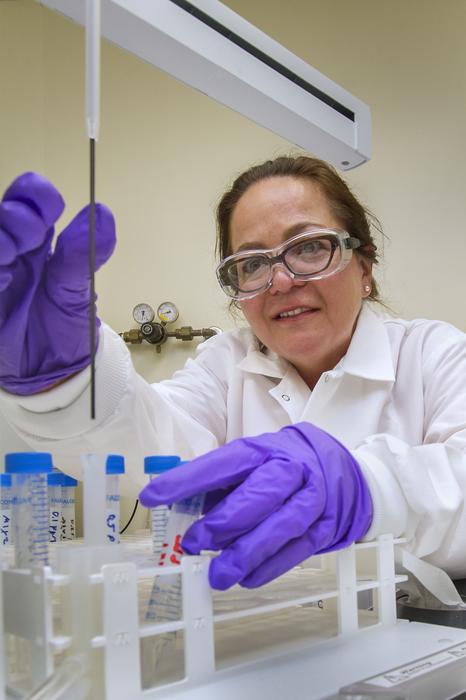UPTON, NY—Cathy Sue Cutler, who has served as director of the Medical Isotope Research and Production (MIRP) program at the U.S. Department of Energy’s (DOE) Brookhaven National Laboratory since 2015, has been tapped to lead a newly created Isotope Research and Production (IP) Department at the Laboratory. The new department brings the components of MIRP—the Brookhaven Linac Isotope Producer (BLIP) and the Radioisotope Research and Production Laboratory (RRPL)—out of the Collider-Accelerator Department (C-AD) to align with DOE’s current classification of facilities. Under Cutler’s leadership, the new department will expand and improve the Lab’s isotope research and production to help meet the nation’s growing need for critical isotopes for medical, industrial, and national security uses.
The establishment of the new department recognizes the importance of this program to the ongoing research at Brookhaven Lab. In her new role, Cutler will continue overseeing an annual budget of ~$20 million and 20 employees.
“This development occurs as the demand for isotopes is growing exponentially due to the innovation of isotopes used in the diagnosis, treatment, and monitoring of various medical conditions, as well as an expansion of the unique industrial applications of isotopes,” Cutler said. “This new department will aid in ensuring our nation’s isotope supply and allow continued research and development into novel isotopes and applications.”
Brookhaven’s isotope research has a long and distinguished history, recapped in last year’s celebration of the 50th anniversary of BLIP. BLIP operates as part of the extensive particle accelerator infrastructure for the Relativistic Heavy Ion Collider—a U.S. Department of Energy Office of Science User Facility for fundamental nuclear physics research located at Brookhaven—with the energy required to produce isotopes that would otherwise be unavailable to science and society. Recent upgrades to the medical isotope facilities have enhanced the Lab’s ability to produce, purify, and ship critical isotopes and radiopharmaceuticals ready for use directly to researchers and doctors around the nation.
These radiopharmaceuticals are vital for noninvasive, personalized cancer treatments that provide patients with high-impact doses to combat tumors without damaging nearby healthy cells. Cutler and others in the department are also leading the development of radioisotopes for “theranostics,” which combine medical therapies with diagnostic medical tests.
The Lab’s 10-year strategic vision for the isotope program, submitted to DOE in 2021, includes additional short-, mid-, and long-range steps for building new capabilities for the accelerator-based irradiation of targets—the first step in the production of isotopes—as well as the radiochemical processing laboratories required to extract these isotopes for use. The plan also includes strategies to develop the future workforce for this field.
“This new department offers faculty and students the opportunity to perform research at Brookhaven that they cannot do at their home institutions. This will attract talent to the field, which is sorely under-resourced, to help generate a pipeline of future researchers,” Cutler said.
The Lab’s plans for the department include a proposed new facility—the Clinical Alpha Radioisotope Processing (CARP) facility—which received DOE critical decision 0 (CD-0, Approve Mission Need) status in December 2022. This facility will increase the production of alpha-emitting isotopes such as actinium-225, which show great promise in treating tumors by delivering a lethal punch to cancer cells. The Lab is working toward achieving the next CARP milestone, CD-1 (Approve Alternative Selection and Cost Range) to bring this new facility online so that more of these promising isotopes can be produced and tested—and if shown to be efficacious, brought to patients around the world.
“This new department will continue to leverage the capabilities of our nuclear physics accelerator infrastructure to meet critical national needs,” said Brookhaven Lab Associate Laboratory Director for Nuclear and Particle Physics Haiyan Gao, who will oversee the new department. “I am delighted that Cathy has agreed to serve as the inaugural chair.”
Cutler has broad interests in nuclear medicine, radiopharmaceutical sciences, radiopharmacology, and cancer research chemistry. She joined Brookhaven Lab in 2015 from the University of Missouri, where she was a professor at the Research Reactor Center and a faculty member at the university’s Nuclear Sciences and Engineering Institute. She holds a B.S. in biochemistry and a Ph.D. in inorganic chemistry from the University of Cincinnati, where she also held a post-doctoral position in analytical chemistry.
In 2022, Cutler received a Brookhaven Science & Technology Pinnacle award for her distinguished contributions to Brookhaven National Laboratory’s science and technology mission. In 2019, she received the Town of Brookhaven’s 33rd Annual Women’s Recognition Award for Achievements in Science, and in 2014, she received the Mizzou Advantage Entrepreneurial Award. She holds 12 patents and has published 95 peer-reviewed journal articles and eight book chapters. She has given more than 100 invited speaker presentations. In June 2023, Cutler was named president-elect for the Society of Nuclear Medicine and Molecular Imaging (SNMMI).
Brookhaven Lab’s isotope program is overseen by the Isotope R&D and Production Program (IP) within the DOE Office of Science (SC), more commonly known as the DOE Isotope Program.
Brookhaven National Laboratory is supported by the Office of Science of the U.S. Department of Energy. The Office of Science is the single largest supporter of basic research in the physical sciences in the United States and is working to address some of the most pressing challenges of our time. For more information, visit science.energy.gov.
Follow @BrookhavenLab on social media. Find us on Instagram, LinkedIn, Twitter, and Facebook.
Related Links
- Producing Radioisotopes for Medical Imaging and Disease Treatment
- BLIP Celebrates 50th Anniversary
- Promising Medical Isotope Made and Processed at Brookhaven Lab








































































